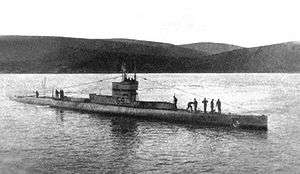HMS G11
 A G-class submarine before bow modification. | |
| History | |
|---|---|
| Name: | HMS G11 |
| Builder: | Vickers, Barrow in Furness |
| Laid down: | 28 March 1915 |
| Launched: | 22 February 1916 |
| Commissioned: | 13 May 1916 |
| Fate: |
Wrecked off Howick, Northumberland, 22 November 1918 NU261176 |
| General characteristics | |
| Class and type: | G-class submarine |
| Displacement: |
|
| Length: | 188 ft 8 in (57.51 m) |
| Beam: | 22 ft 8 in (6.91 m) |
| Draught: | 13 ft 7 in (4.14 m) |
| Installed power: |
|
| Propulsion: |
|
| Speed: |
|
| Range: |
|
| Capacity: | 44.14 long tons (44.85 t) diesel fuel |
| Complement: | 31 |
| Armament: | 1 × 3 in (76 mm) gun, 1 × 12-pounder gun, 4 × 18-inch (450-mm) torpedo tubes (2 bow, 2 beam), 1 × stern 21 inch torpedo tube (10 torpedoes, all tubes combined) |
HMS G11 was a G-class submarine of the Royal Navy in service during the First World War. One of six of her class built by Vickers at Barrow in Furness, she was launched on 22 February 1916, and commissioned on 13 May 1916.
War service
Like the rest of her class, G11's role was to patrol an area of the North Sea in search of German U-boats.
Loss
On 22 November 1918, whilst under the temporary command of Lieutenant Commander George Fagan Bradshaw, DSO , G11 was returning to her base at Blyth, Northumberland, from Dogger Bank patrol following the Armistice. Sailing through dense fog, she overshot Blyth and ran aground on rocks below cliffs near Howick, some 30 mi (48 km) to the north. The boat's log had been disabled earlier and Bradshaw, unfamiliar with the larger G class boats, underestimated her speed in the inclement weather, with the result that the boat had travelled substantially further than he had reckoned. The impact tore the keel off and the boat was abandoned, two of her crew drowning during the evacuation. The body of Telegraphist George Philip Back was recovered and buried in the churchyard of St Peter & St Paul, Longhoughton; the body of Stoker Pliny Foster was never found.[1]
G11's regular captain Lieutenant Richard Douglas Sandford VC had not sailed on her last mission, having succumbed to typhoid fever. He died at Eston hospital the day after learning his ship had been lost.
Remains of G11 can still be seen at low tide .
NB: The Royal Navy Submarine Museum, Gosport, erroneously lists the location of G11's wrecking as Harwich, Suffolk, over 350 mi (560 km) away .
References
- Colledge, J. J.; Warlow, Ben (2006) [1969]. Ships of the Royal Navy: The Complete Record of all Fighting Ships of the Royal Navy (Rev. ed.). London: Chatham Publishing. ISBN 978-1-86176-281-8. OCLC 67375475.
Coordinates: 55°27′07″N 1°35′20″W / 55.452°N 1.589°W